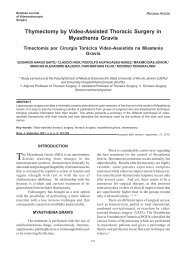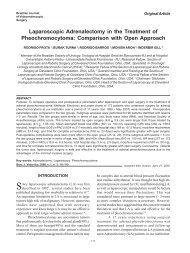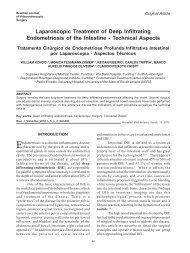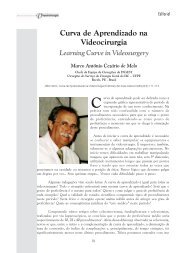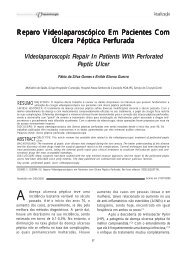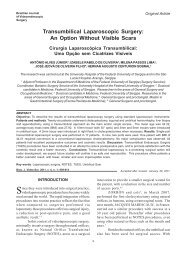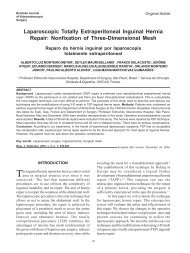Understanding Randomized Controlled Trials - Sobracil
Understanding Randomized Controlled Trials - Sobracil
Understanding Randomized Controlled Trials - Sobracil
Create successful ePaper yourself
Turn your PDF publications into a flip-book with our unique Google optimized e-Paper software.
174 Oliveira et al.<br />
Bras. J. Video-Sur., October / December 2010<br />
occur not because of the treatment in question, but<br />
for other reasons: the natural history of the disease<br />
process, psychological aspects, etc. Sometimes, as<br />
for example, in the treatment of acute pelvic<br />
inflammatory disease, it is inappropriate to use of a<br />
placebo or have no treatment as the control. In these<br />
cases, the investigator can study a new drug using as<br />
a control group the treatment considered the standard<br />
of care.<br />
The next step is to verify how the<br />
randomization was done between the treatment and<br />
control groups. Randomization implies the chance<br />
assignment of patients so that each case has the same<br />
probability of being allocated to the intervention or<br />
control group. Non-randomized controlled studies are<br />
viewed as not have the same weight of scientific<br />
evidence as RCTs, because in most cases the<br />
intervention and control groups are not equivalent (i.e.,<br />
there is some bias). For example, in a study comparing<br />
Laparoscopic Burch Urethropexy and laparotomy, one<br />
could imagine that patients who were thinner and who<br />
had milder complaints of stress urinary incontinence<br />
might be selected for laparoscopy. If this selection<br />
bias were to occur, one could not compare these two<br />
distinct groups of patients, as it would put laparotomy<br />
at a disadvantage.<br />
Randomization ends up balancing known<br />
factors such as age, weight, stage of illness, as well<br />
as unknown (or immeasurable) factors (e.g., some<br />
genetic factor that cannot readily be detected that<br />
might influence the clinical outcome). True<br />
randomization should be done with random numbers<br />
generated by computer (there are also tables for this<br />
purpose) that are placed in numbered sealed envelopes<br />
that are opened immediately before treatment<br />
is administered. Inappropriate methods of<br />
randomization – sometimes called “quasirandomized”<br />
– include, for example, doing<br />
laparoscopic surgery on Mondays and Wednesdays<br />
and laparotomies on Tuesday and Thursday, or<br />
alternating laparoscopic surgery and laparotomy.<br />
These methods permit failures in the random<br />
assignment, even if unconsciously. For example, the<br />
surgeon (or the physician who referred the patient<br />
for surgery and is familiar with the design of the<br />
study) may consider a patient too obese for<br />
laparoscopy and subconsciously (or intentionally)<br />
postpone the surgery for a day, in order to coincide<br />
with day or turn for a laparotomy. Appropriate<br />
randomization will generally prevent this type of bias.<br />
Nevertheless, well executed randomization does not<br />
guarantee the equivalence of the groups, especially<br />
with small samples. Before analyzing the data, it is<br />
good idea to check if there really was a balanced<br />
assignment of patients, particularly regarding those<br />
characteristics which directly influence the outcome,<br />
such as disease stage, age, weight, etc.). Unbalanced<br />
groups may bias the results.<br />
One should also be concerned if the method<br />
used in measuring the clinical endpoint of interest<br />
was double-blinded. This means that neither the<br />
patient nor the professional making the assessment<br />
(for example, assessing the degree of<br />
postoperative pain in patients who may or may not<br />
have received the anesthetic marcaine in a surgical<br />
wound) may know whether the treatment was<br />
applied. The physician may unconsciously not fully<br />
appreciate the complaints of patients who belong<br />
to the group that received the investigational<br />
treatment, distorting the results. The patient may<br />
want to believe in a particular investigational or<br />
novel treatment and thus downplay or underreport<br />
symptoms. The double-blind method attempts to<br />
eliminate this potential type of subliminal bias. As<br />
with comparisons of clinical and surgical<br />
treatments, a double-blind approach is not always<br />
feasible. But you should not neglect to use a double<br />
blind approach whenever possible.<br />
Another important aspect is the duration of<br />
follow-up. First make sure that the duration of followup<br />
was adequate to assess the clinical outcome of<br />
interest. For example, in assessing the use of<br />
laparoscopic transection of the utero-sacral ligaments<br />
for relief of dysmenorrhea, the duration of follow-up<br />
should be at least one year, as the high number of<br />
relapses after this period is well established. Another<br />
relevant issue is whether the percentage of patients<br />
who were lost to follow-up was similar among the<br />
groups. Follow-up rates below 70% make it virtually<br />
impossible to analyze the data, as the abandonment<br />
may have occurred because of side effects or even<br />
deaths stemming from the treatment.<br />
The aforementioned errors are systematic, as<br />
opposed to random errors that can occur when<br />
working with any sample. The appropriate statistical<br />
analysis aims to identify whether the differences in<br />
results were obtained due to random errors or if a<br />
difference really does exist between the intervention<br />
and the control. The basic concepts of statistics will<br />
be addressed in the next issue of this journal.




